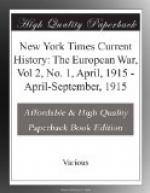Amazing meals appeared at most amazing places, all the menus carefully thought out days before. Imagine fresh trout served you with other famous French delicacies in a little house in the battle zone, where only a few hundred yards of barbed wire and a few feet more of air separated you from the German trenches. During the German advance, also after the battle of the Marne, there were many towns in the districts where it was impossible to obtain tobacco, spirits, or food staples. This condition has entirely abated, and the commissariat is now so well supplied that soldiers have sufficient tobacco even in the trenches.
It was my privilege to take a brief ride at the front in an antebellum motor bus of glorious memory—there being nothing left in Paris but the subway. Buses are now used to carry fresh meat, although they have been used in transporting troops and also ammunition. We trundled quite merrily along a little country road in Northern France, the snow-white fields on either side in strange contrast to the scenery when last I rode in that bus. I am sure I rode in the same bus before the war in my daily trips to the Paris office of THE NEW YORK TIMES. Its sides are bullet riddled now, but the soldier conductor still jingles the bell to the motorman, although he carries a revolver where he used to wear the register for fares.
Trench life was one of the most interesting surprises of the trip. Every night since the war began I have heard pitying remarks about “the boys in the trenches,” especially if the nights were cold. I was, therefore, prepared to find the men standing in water to the knees, shivering, wretched, sick, and unhappy. I found just the contrary—the trenches were clean, large, and sanitary, although, of course, mud is mud. I found the bottoms of the trenches in every instance corduroy-lined with modern drains, which allowed the feet to keep perfectly dry, and also the large dugouts where the men, except those doing sentry duty, sleep comfortably on dry straw. There are special dugouts for officers and artillery observers.
I also visited a large, perfectly equipped Red Cross First Aid camp, all built underground, extending from one line of trenches to another. All trenches, communication traverses, and observatory dugouts have received names which are printed on shingles affixed to the trenches on little upright posts. For instance, we entered one section of the trenches through Boyau d’Espagne, we traversed Avenue de Bois, Avenues Wagram and Friedland, and others commemorating Napoleonic victories. The dugouts of officers and observers were all called villas—Villa Chambery, Villa Montmorency being examples. It all seemed like cozy camp life underground except that three times the morning of our visit it was necessary to flatten ourselves against the mud sidewalls while dead men on crossed rifles were carried out, every head in that particular bit of trench being bared as the sad procession disappeared.




